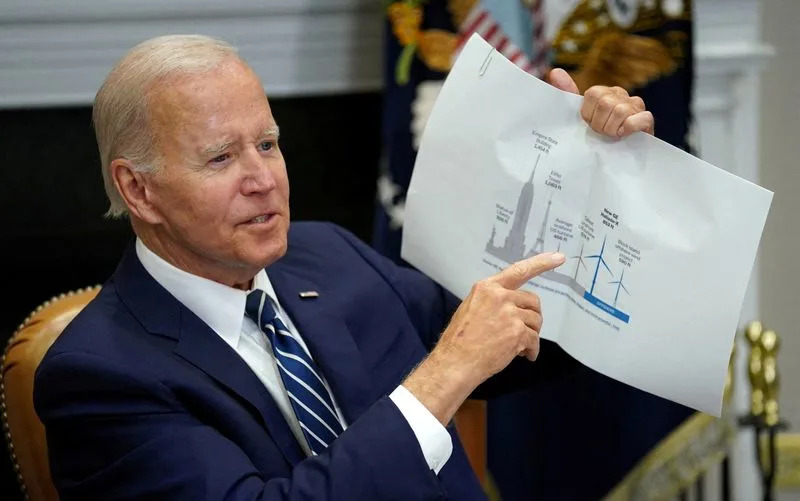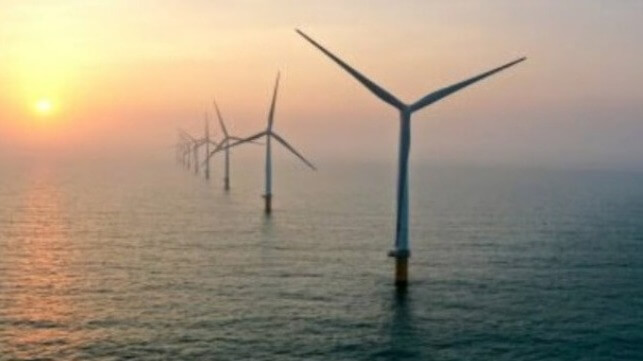Wed, September 6, 2023

Biden attends a meeting on the Federal-State Offshore Wind Implementation Partnership at the White House in Washington
By Scott DiSavino and Nerijus Adomaitis
(Reuters) - The value of Danish energy company Orsted, the world's largest offshore wind farm developer and a big player in the U.S., has plunged about 31% since it declared $2.3 billion in U.S. impairments in late August due to supply delays, high interest rates and a lack of new tax credits.
The company is just one of several energy firms trying to build new offshore wind farms in the U.S., but the pain it is feeling is rippling across the entire industry, raising questions about the future of fleet of projects that U.S. President Joe Biden hopes can help fight climate change.
Biden’s administration wants the U.S. to deploy 30,000 megawatts (MW) of offshore wind by 2030 from a mere 41 MW now, a key part of his plan to decarbonize the power sector and revitalize domestic manufacturing, and has passed lucrative subsidies aimed at helping companies do that.
But even with regulatory rules and subsidies in place, developers are facing a whole new set of headwinds.
Here is what they are:
INFLATION
The U.S. offshore wind industry has developed much more slowly than in Europe because it took years for the states and federal government to provide subsidies and draw up rules and regulations governing the industry, slowing leasing and permitting.
However, as government policies started to line up in the industry's favor in recent years, offshore wind developers unveiled a host of new project proposals, mostly off the U.S. East Coast. Two small projects came into operation - Orsted's five-turbine Block Island wind farm off Rhode Island and the first two test turbines of U.S. energy firm Dominion Energy's Coastal Virginia Offshore Wind off Virginia. Then came a hitch.
The COVID-19 pandemic gummed up supply chains and increased the cost of equipment and labor, making new projects far more expensive than initially projected.
"It appears the offshore wind industry bid aggressively for early projects to gain a foothold in a promising new industry, anticipating steep (cost) declines similar to those for onshore wind, solar and batteries over the past decade," Eli Rubin, senior energy analyst at energy consulting firm EBW Analytics Group, told Reuters.
"Instead, steep cost gains threw project financing and development into disarray," Rubin said, noting many contracts will likely be renegotiated as states look to decarbonize, with higher prices ultimately falling onto power customers.
INTEREST RATES
Financing costs also spiraled as the U.S. Federal Reserve boosted interest rates to tame inflation.
Many contracts for offshore wind projects have no mechanism for adjustment in the case of higher interest rates or costs.
Some developers have paid to get out of their contracts rather than build them and face years of losses or low returns.
In Massachusetts, two offshore wind developers, SouthCoast Wind and Commonwealth Wind, for example, agreed to pay to terminate deals that would have delivered around 2,400 MW of energy, enough to power over one million homes.
In New York, offshore wind developers also sought to boost the price of power produced at their projects. Norway's Equinor and its partner BP are seeking a 54% increase for the power produced at three planned offshore wind farms - Empire Wind 1 and 2 and Beacon Wind.
Orsted, meanwhile, told utility regulators in June that it would not be able to make a planned final investment decision to build its proposed 924-MW Sunrise Wind project unless its power purchase agreement was amended to factor in inflation.
INSUFFICIENT SUBSIDIES
Biden’s administration has sought to supercharge clean energy development with passage of the Inflation Reduction Act (IRA), a sweeping law that provides billions of dollars of incentives to projects that fight climate change.
Since the law passed last year, companies have announced billions of dollars in new manufacturing for solar and electric vehicle (EV) batteries across the U.S.
But the offshore wind industry is not fully satisfied.
Bonus incentives for using domestic materials and for siting projects in disadvantaged communities are too hard to secure, developers say, and they are crucial to making projects work in a high-cost environment.
The credits are each worth 10% of a project's cost and can be claimed as bonuses on top of the IRA's base 30% credit for renewable energy projects - bringing a project's total subsidy to as much as 50%.
Equinor, France's Engie, Portugal's EDP Renewables, and trade groups representing other developers pursuing offshore wind projects in the U.S. told Reuters they are pressing officials to rewrite the requirements, and warning of lost jobs and investments otherwise.
(Reporting by Scott DiSavino in New York, Nerijus Adomaitis in Oslo and Nichola Groom in Culver City; Editing by Simon Webb and Marguerita Choy)
Massachusetts Looks to Push Ahead with Offshore Wind as Developers Back Out

Massachusetts once again is finding itself at the forefront of the emerging challenges for the offshore wind energy sector. One of the first states to move forward with projects, Governor Maura Healey is releasing the state’s fourth RFP for wind projects while regulators are confronted by another major project that is seeking to rip up its agreements.
The changing economics and the realities of developing wind farm projects came to the forefront late last year in Massachusetts when the first of the projects said the economics of their deals no longer worked. Avangrid Renewables, part of Spain’s IBERDROLA Group, started the issue last year by petitioning the DPU (Department of Public Utilities) to dismiss its review of the Commonwealth Wind contracts with the power companies. They cited the changing economics saying that the project needed to be rebid in the 2023 solicitation for offshore wind. The Mayflower Wind project, which is a partnership between Shell New Energies and Ocean Winds North America (a joint venture between EDP Renewables and ENGIE), also began advocating for changes to its power agreements.
The developers of Mayflower Wind, renamed SouthCoast Wind, have now confirmed they are going to walk away from their agreements despite the efforts by the DPU to force the developers to move forward under the contracts that were negotiated in June 2022. The lease for the project was originally awarded in December 2018 and went into effect in 2019 calling for a proposed offshore wind farm in U.S. federal waters about 30 miles south of Martha’s Vineyard and 23 miles south of Nantucket, with an initial capacity of 804 MW and a longer-term potential for up to 2.4 GW.
They had moved forward with the project and early preparations, but in June reported they had recently initiated discussions with representatives of the Commonwealth of Massachusetts and the Massachusetts electric distribution companies to terminate the existing Power Purchase Agreements. In a filing last week, they confirmed they will pay $60 million to walk away from the agreements while calling for them to be rebid in the next round to reflect the changed economics of offshore wind development. They need approval from the regulators.
This follows a filing by Avangrid in July that proposed a similar walkaway from its power agreements. The company said it would pay a total of $48 million to three power companies to terminate the agreements. The company says it must have more favorable financial terms to make the project viable.
Of Massachusetts' first three big offshore wind projects, only the Vineyard Wind 1 farm has moved forward. It calls for an 800-megawatt project located 15 miles off the coast of Martha’s Vineyard. In August, turbine installation began with the goal of completing the project which is being developed in a partnership between funds of Copenhagen Infrastructure Partners (CIP) and Avangrid Renewables by the end of 2023.
Despite the troubles in the industry, Massachusetts looks to push forward becoming what the governor is calling an offshore wind industry hub. They released the state’s fourth RFP, its largest offshore wind solicitation to date. It would more than double the state’s current wind power solicited compared to previous procurements.
Bids are due by January 31, 2024, and they plan to execute contracts by August 14, 2024. The RFP envisions selecting offshore wind generation of up to 3.6 GW. The governor highlights that it would be equal to a quarter of the state’s annual electricity demand.
In announcing the new effort, the governor highlighted that the state is not insensitive to the challenges driven by inflation and other macroeconomic trends. The next round under the RFP allows for additional flexibility including bidders can submit an alternative indexed pricing proposal. They are also highlighting the availability of federal tax credits and incentives.
Those tax programs however have become one of the flash points in the emerging rift over development. Ørsted expressed the problems it was experiencing saying the credits are falling short of projections and the hurdles are too steep because of the lack of a developed domestic U.S. supply chain. Executives from Ørsted, Equinor, and ENGIE all told Reuters this week that the credits under the Inflation Reduction Act are not working as planned and need to be revised.
No comments:
Post a Comment